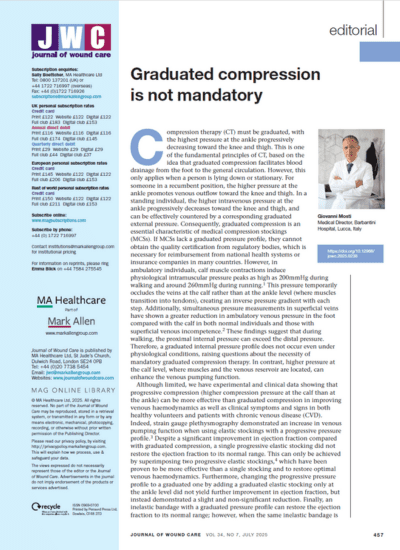Why progressive compression is the future – Backed by science
We are pleased to share new clinical insights that question long-standing assumptions about compression therapy. Recent research by Giovanni Mosti offers a fresh perspective on compression therapy, particularly for active patients with chronic venous disease (CVD/CVI).

Rethinking compression: from graduated to progressive
Traditional graduated compression therapy involves applying the highest pressure at the ankle, gradually decreasing towards the knee or thigh. This approach has been the standard for decades and is effective for patients who are immobile or lying down. However, when a person is active, walking or standing, the situation changes.
According to Mosti’s research, movement causes muscle contractions that create an internal reverse pressure gradient. In such cases, the traditional compression model no longer reflects how the body actually behaves.
Why progressive compression is better for active patients
Progressive compression applies higher pressure at the calf than the ankle. This technique has shown significantly better outcomes in active individuals and those who stand for long periods.
Clinical findings have shown the following benefits:
- Improved venous return and blood flow
- Reduction in pain and oedema
- Restoration of ejection fraction, by superimposing two progressive compression stockings, which traditional methods cannot achieve
Evidence in patients with CVI
In a large randomised study involving 401 patients with moderate to severe chronic venous disease (CEAP C2s–C5), progressive compression was found to be more effective in reducing symptoms. Another study indicated that progressive compression was better tolerated by patients, including those with arterial conditions.
These results challenge the belief that graduated compression is always the best option, and they point to a shift towards more tailored, dynamic solutions.
How PneumaSox supports this approach
The findings provide strong support for innovative systems like PneumaSox, which uses air pressure to deliver a controlled, progressive compression profile. PneumaSox not only offers effective therapy but also makes treatment more convenient for both patients and healthcare professionals.
Additional benefits of PneumaSox
- Easy to apply, even by the patient themselves
- Application is three times faster than traditional bandaging
- Saves time and reduces cost, as no bandaging skills or repeated bandaging are needed
- Reusable for up to six months, reducing waste
- Comfortable to wear with shoes
Conclusion
While graduated compression is still widely used in clinical practice, it is not always the most effective solution. Progressive compression, as used in PneumaSox, delivers better haemodynamic and clinical results, especially for active individuals and those with CVI.
Read the full research article on the PneumaSox page
